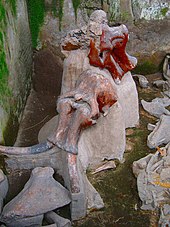Museo de Paleontología de Tocuila
The Museo de Paleontología de Tocuila near the central Mexican city of Texcoco exhibits fossils from one of the richest fauna sites from the Young Pleistocene in America. This is located in a former tributary of Lake Texcoco . The numerous bones , mostly of mammoths , discovered there by an international group of archaeologists , are estimated to be between 10,000 and 12,000 years old.
location
The Museo de Paleontología de Tocuila is located at 16 de Septiembre in the village of San Miguel Tocuila , Mexico state .
history
The site was discovered in July 1996 during excavation work. While Joaquín Ramírez was supervising the construction of a cistern , he noticed fossilized remains of bones. His brother Celso, the owner of the property, informed the Instituto Nacional de Antropología e Historia (INAH; National Institute for Anthropology and History) about the find. The institute carried out several on-site studies aimed at examining the unusually high concentration of bones in various animals.
The Museo de Paleontología de Tocuila was opened to the public in November 2001 with the support of the landowner, the village, the Universidad Autónoma Chapingo and the INAH.
Description of the site
In the 28 square meters that have been explored so far, the remains of at least seven mammoths ( Mammuthus columbi ) of various ages, from young to adult, have been discovered at a depth of three meters , along with bones of several animals such as rabbits, aquatic animals and ungulates (camel, horse , Bison). Most studies of the remains indicate an age of 10,000 to 12,000 years.
Hypotheses
There are several hypotheses that try to explain why so much bone debris has accumulated in a single place.
The first statements discussed the possibility that the flooding of the river, which then flowed into Lake Texcoco, surprised, carried away, drowned and buried the mammoths and the other animals together.
Later investigations pointed more to a lahar (volcanic mud flow). Claus Siebe, Peter Schaaf and Jaime Urrutia-Fucugauchi suspected that the mud flow was triggered by the Popocatépetl volcano , while the results of the research by S. Gonzalez, D. Huddart, L. Morett-Alatorre, J. Arroyo-Cabrales and OJ Polaco on indicate the Nevado de Toluca .
Another possible explanation for bone accumulation is the study by J. Arroyo-Cabrales, E. Johnson and L. Morett. After analyzing the bone fragments, they hypothesized that there was human bone fissure activity at the location, perhaps as was the practice in North America to make tools or arrowheads.
swell
- ↑ a b c d Claus Siebe, Peter Schaaf and Jaime Urrutia-Fucugauchi: Mammoth bones embedded in a late Pleistocene lahar from Popocatepetl Volcano, near Tocuila, central Mexico. GSA Bulletin, October 1999, v. 111, no.10, p. 1550-1562
- ↑ a b México Desconocido No. 322, December 2003
- ↑ a b c d e S. Gonzalez, D. Huddart, L. Morett-Alatorre, J. Arroyo-Cabrales, OJ Polaco: Mammoths, volcanism and early humans in the basin of Mexico during the Late Pleistocene / Early Holocene , Rome 2001 , The World of Elephants - International Congress
- ↑ a b J. Arroyo-Cabrales, E. Johnson, L. Morett: Mammoth bone technology at Tocuila in the Basin of Mexico. Rome 2001, The World of Elephants - International Congress ; p.419-423
- ↑ Jerjes Pantoja Alor: ¿Por qué se extinguieron los mamuts? Jornada, April 24, 2000
Coordinates: 19 ° 31 ′ 13 ″ N , 98 ° 54 ′ 28 ″ W.


